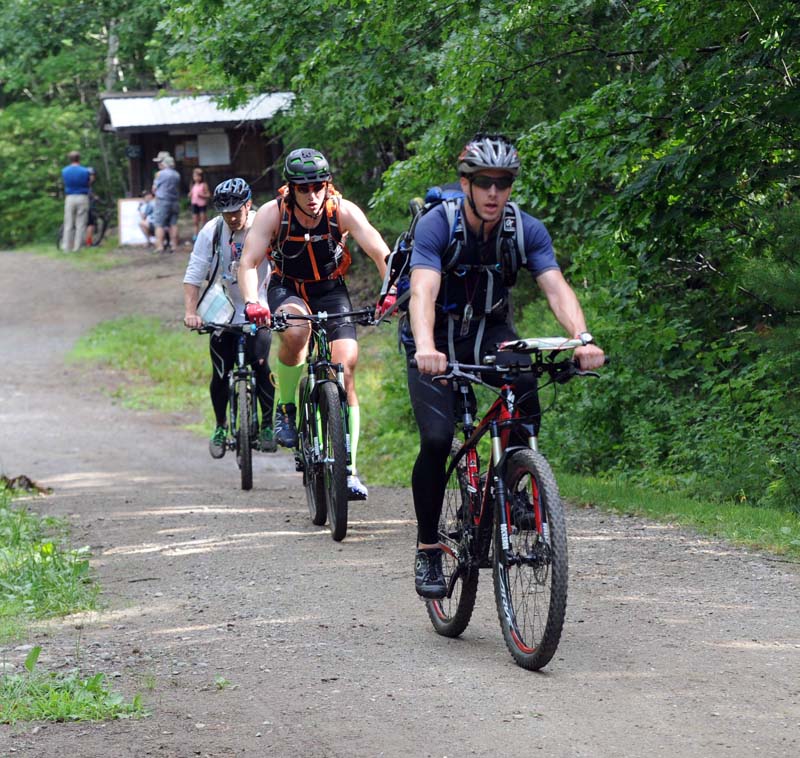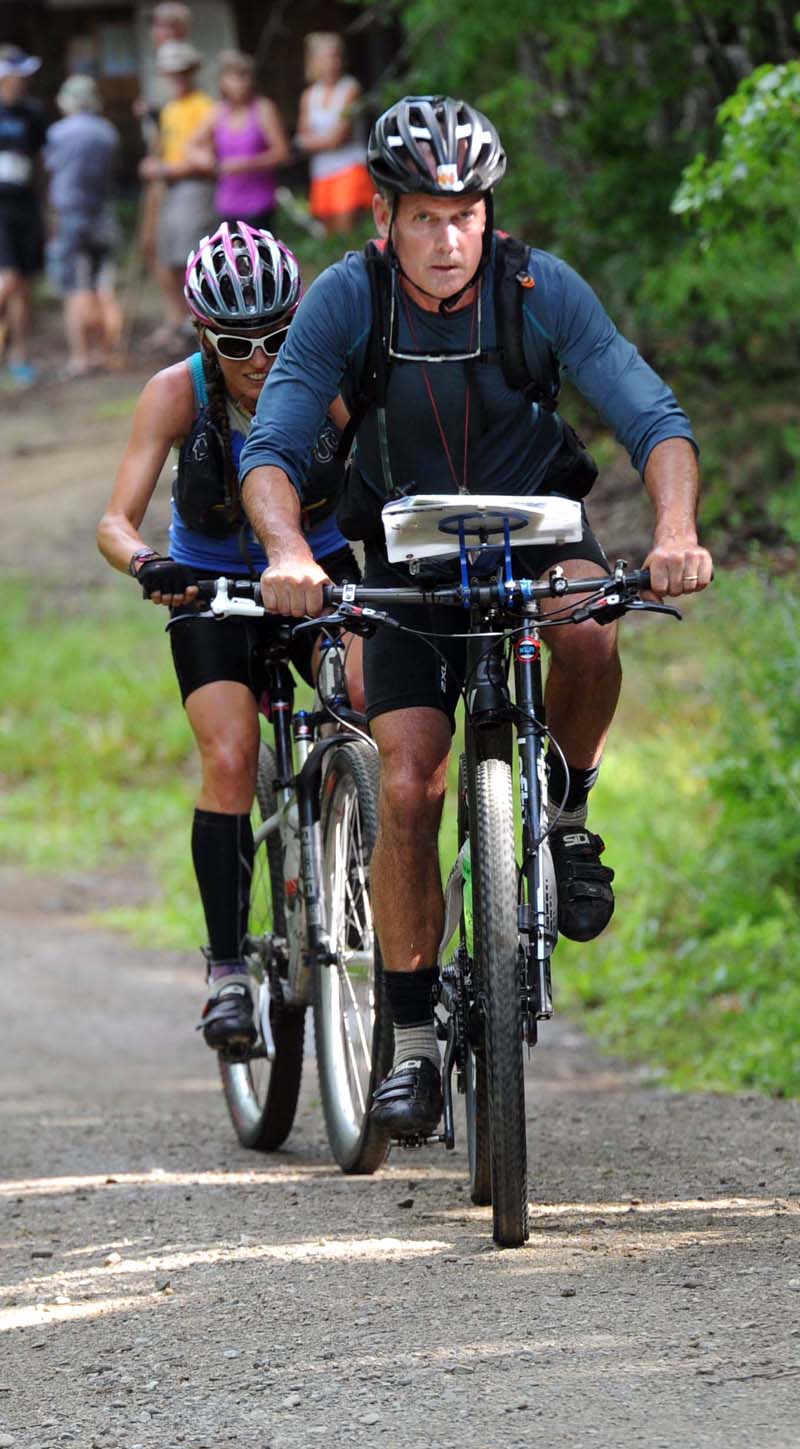
Mountain bikers compete in a race at Hidden Valley Nature Center in Jefferson. (LCN file photo)
There are several places to go mountain biking in Lincoln County. The best two choices are the Schmid Preserve in Edgecomb and Hidden Valley Nature Center in Jefferson. In addition, Oxbow Brewing Co. in Newcastle offers a 1.5-mile blue-blazed mountain bike trail on hilly terrain.
There are several other multiple-use trails in the county, but preserve owners do not promote the use of mountain bikes on them to prevent damage to their trails.
Schmid Preserve
The 767-acre Schmid Preserve is owned by the town of Edgecomb. It can be accessed from Middle Road and Old County Road. Three old, intersecting dirt roads run through the property: Old County Road, Mount Hunger East, and Mount Hunger North. In addition, there are several other wider trails that can be accessed by mountain bike, including Charlotte’s Trail, opened in 2019.
Directions to Middle Road parking area: From Route 1 in Newcastle, turn onto Lynch Road, drive 2.4 miles, and turn left onto Middle Road. Drive 1.1 miles and the parking area and kiosk will be on the left. From Route 27 in Edgecomb, turn onto Middle Road, drive eight-tenths of a mile, and the kiosk and parking area will be on the right.
Directions to Old County Road parking area: From Route 27 in Edgecomb, turn onto Old County Road. Park in the designated area before the gate.
HVNC

Mountain bikers ride out of Hidden Valley Nature Center in Jefferson during a 2016 race. (LCN file photo)
The 800-acre Hidden Valley Nature Center is owned by Midcoast Conservancy. There are 25 miles of trail on the property, including several that are accessible by mountain bike.
HVNC is on Egypt Road in Jefferson. From the intersection of Route 194 and Route 215 in Newcastle, turn onto South Clary Road. Drive 4.4 miles and turn left onto Egypt Road. HVNC is a half-mile down Egypt Road on the right. From Route 126 in Jefferson, take Route 215 (South Clary Road), drive 4.4 miles, and take a right onto Egypt Road.
Oxbow
Oxbow Brewing Co. is located at 274 Jones Woods Road in Newcastle. There is a 1.5-mile trail (marked by a picture of a bike) on the 18-acre, hilly site. This trail is also open to walkers.
Maps and recreational waivers are available in the tasting room when open.
Rules of the trail
The International Mountain Bike Association has six “rules of the trail” for being a polite and responsible rider, as follows:
Ride on open trails only: Stick to riding trails that are open to bikers and always respect trail closures or day-based directional rules. Following the rules might seem contrary to mountain biking’s rebellious roots, but it’s actually what’s made the mountain bike community so strong. The public access enjoyed today is thanks to avoiding trespassing on private land and obtaining required permits or authorization.
Following this rule of mountain bike trail etiquette is also essential to gain access to new areas for mountain biking. Always steer clear of protected land that doesn’t allow bikers. It’s illegal to ride a bike on land designated as a state or federal wilderness area.
Leave no trace: No list of rules is complete without a reminder to leave the trails as you found them – or better. This means you should:
· Avoid wet and muddy trails, which are susceptible to rutting and damage.
· Not cut switchbacks or create cheater lines.
· When you yield to other users, pull to the edge of the trail, not off the trail.
Leaving no trace also means packing out whatever you packed in. Level up your etiquette and pick up trash when you see it.
Control your bike: Getting stoked and sendy is what mountain biking is all about, but try not to lose control. Being a responsible, safety-minded mountain biker means you make it a point to adhere to speed regulations and recommendations, and always ride within your limits.
Yield to others: One of the most common questions about mountain bike etiquette is, “Who has the right of way?” The conventions for yielding and passing vary from area to area, but mountain bikers should generally yield to all other trail users.
Then there’s the age-old question: “Do uphill or downhill riders have the right of way?” Unless otherwise noted, yield to the uphill riders. Use your eyes and ears to anticipate other users on the trail. When rounding blind corners, slow down, and call out or ring a bell to let other users know you’re coming.
Respect animals: Mountain bikes make it easy to sneak up on animals. Whether you’re approaching wildlife or a person on horseback, it’s easier than you think to startle an animal and create a dangerous situation. Just think about who will win in a face-off between a 1,500-pound horse and a person on a carbon-fiber trail bike. With this in mind, give animals room and time to adjust to your presence. Don’t assume an animal notices you, and don’t ever sneak up on them intentionally.
Plan ahead: The International Mountain Bike Association’s final guideline for mountain bike etiquette is to strive for self-sufficiency and safety. Before you visit a trail system, do some research to ensure that:
· The trails and conditions are within your ability level.
· Your bike is in good working order.
· You’re prepared with the necessary tools and parts to make common trail-side repairs – a spare tube or tubeless repair kit, tire levers, a multitool, a pump or carbon dioxide inflator, and a replacement chain link. Tuck a small first-aid kit into your pack as well for human repairs.
· Bring enough food and water to sustain yourself for a ride.
· Wear a helmet.



